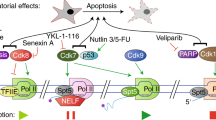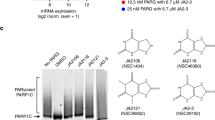Abstract
Cdc7 is an essential kinase that promotes DNA replication by activating origins of replication. Here, we characterized the potent Cdc7 inhibitor PHA-767491 (1) in biochemical and cell-based assays, and we tested its antitumor activity in rodents. We found that the compound blocks DNA synthesis and affects the phosphorylation of the replicative DNA helicase at Cdc7-dependent phosphorylation sites. Unlike current DNA synthesis inhibitors, PHA-767491 prevents the activation of replication origins but does not impede replication fork progression, and it does not trigger a sustained DNA damage response. Treatment with PHA-767491 results in apoptotic cell death in multiple cancer cell types and tumor growth inhibition in preclinical cancer models. To our knowledge, PHA-767491 is the first molecule that directly affects the mechanisms controlling initiation as opposed to elongation in DNA replication, and its activities suggest that Cdc7 kinase inhibition could be a new strategy for the development of anticancer therapeutics.
This is a preview of subscription content, access via your institution
Access options
Subscribe to this journal
Receive 12 print issues and online access
$259.00 per year
only $21.58 per issue
Buy this article
- Purchase on Springer Link
- Instant access to full article PDF
Prices may be subject to local taxes which are calculated during checkout





Similar content being viewed by others
References
Bell, S.P. & Dutta, A. DNA replication in eukaryotic cells. Annu. Rev. Biochem. 71, 333–374 (2002).
Chabner, B.A. et al., in The Pharmacological Basis of Therapeutics 10th edn. (eds. Hardman, J.G., Limbird, L.E. & Goodman Gliman, A.) 1389–1460 (McGraw-Hill, New York, 2001).
Bartek, J., Lukas, C. & Lukas, J. Checking on DNA damage in S phase. Nat. Rev. Mol. Cell Biol. 5, 792–804 (2004).
Branzei, D. & Foiani, M. The DNA damage response during DNA replication. Curr. Opin. Cell Biol. 17, 568–575 (2005).
Bergman, A.M., Pinedo, H.M. & Peters, G.J. Determinants of resistance to 2′,2′-difluorodeoxycytidine (gemcitabine). Drug Resist. Updat. 5, 19–33 (2002).
Longley, D.B. & Johnston, P.G. Molecular mechanisms of drug resistance. J. Pathol. 205, 275–292 (2005).
Hartwell, L.H., Culotti, J., Pringle, J.R. & Reid, B.J. Genetic control of the cell division cycle in yeast. Science 183, 46–51 (1974).
Sato, N., Arai, K. & Masai, H. Human and Xenopus cDNAs encoding budding yeast Cdc7-related kinases: in vitro phosphorylation of MCM subunits by a putative human homologue of Cdc7. EMBO J. 16, 4340–4351 (1997).
Jiang, W. & Hunter, T. Identification and characterization of a human protein kinase related to budding yeast Cdc7p. Proc. Natl. Acad. Sci. USA 94, 14320–14325 (1997).
Hess, G.F. et al. A human homolog of the yeast CDC7 gene is overexpressed in some tumors and transformed cell lines. Gene 211, 133–140 (1998).
Jiang, W., McDonald, D., Hope, T.J. & Hunter, T. Mammalian Cdc7-Dbf4 protein kinase complex is essential for initiation of DNA replication. EMBO J. 18, 5703–5713 (1999).
Kim, J.M. et al. Inactivation of Cdc7 kinase in mouse ES cells results in S-phase arrest and p53-dependent cell death. EMBO J. 21, 2168–2179 (2002).
Kumagai, H. et al. A novel growth- and cell cycle-regulated protein, ASK, activates human Cdc7-related kinase and is essential for G1/S transition in mammalian cells. Mol. Cell. Biol. 19, 5083–5095 (1999).
Montagnoli, A. et al. Cdc7 inhibition reveals a p53-dependent replication checkpoint that is defective in cancer cells. Cancer Res. 64, 7110–7116 (2004).
Montagnoli, A. et al. Drf1, a novel regulatory subunit for human Cdc7 kinase. EMBO J. 21, 3171–3181 (2002).
Montagnoli, A. et al. Identification of Mcm2 phosphorylation sites by S-phase-regulating kinases. J. Biol. Chem. 281, 10281–10290 (2006).
Forsburg, S.L. Eukaryotic MCM proteins: beyond replication initiation. Microbiol. Mol. Biol. Rev. 68, 109–131 (2004).
Masai, H. et al. Human Cdc7-related kinase complex. In vitro phosphorylation of MCM by concerted actions of Cdks and Cdc7 and that of a criticial threonine residue of Cdc7 bY Cdks. J. Biol. Chem. 275, 29042–29052 (2000).
Tenca, P. et al. Cdc7 is an active kinase in human cancer cells undergoing replication stress. J. Biol. Chem. 282, 208–215 (2007).
Gonzalez, M.A., Tachibana, K.E., Laskey, R.A. & Coleman, N. Innovation: control of DNA replication and its potential clinical exploitation. Nat. Rev. Cancer 5, 135–141 (2005).
Shreeram, S., Sparks, A., Lane, D.P. & Blow, J.J. Cell type-specific responses of human cells to inhibition of replication licensing. Oncogene 21, 6624–6632 (2002).
Feng, D., Tu, Z., Wu, W. & Liang, C. Inhibiting the expression of DNA replication-initiation proteins induces apoptosis in human cancer cells. Cancer Res. 63, 7356–7364 (2003).
Vanotti, E. et al. Cdc7 kinase inhibitors: pyrrolopyridinones as potential antitumor agents. 1. Synthesis and structure-activity relationships. J. Med. Chem. 51, 487–501 (2008).
Anderson, D.R. et al. Pyrrolopyridine inhibitors of mitogen-activated protein kinase-activated protein kinase 2 (MK-2). J. Med. Chem. 50, 2647–2654 (2007).
Pevarello, P. et al. 3-Aminopyrazole inhibitors of CDK2/cyclin A as antitumor agents. 1. Lead finding. J. Med. Chem. 47, 3367–3380 (2004).
Soncini, C. et al. PHA-680632, a novel Aurora kinase inhibitor with potent antitumoral activity. Clin. Cancer Res. 12, 4080–4089 (2006).
Knight, Z.A. & Shokat, K.M. Features of selective kinase inhibitors. Chem. Biol. 12, 621–637 (2005).
Shapiro, G.I. Cyclin-dependent kinase pathways as targets for cancer treatment. J. Clin. Oncol. 24, 1770–1783 (2006).
Palancade, B. & Bensaude, O. Investigating RNA polymerase II carboxyl-terminal domain (CTD) phosphorylation. Eur. J. Biochem. 270, 3859–3870 (2003).
Kim, J.M. et al. Cdc7 kinase mediates Claspin phosphorylation in DNA replication checkpoint. Oncogene, published online, doi:10.1038/sj.onc.1210994 (17 December 2007).
Cai, D., Latham, V.M., Jr., Zhang, X. & Shapiro, G.I. Combined depletion of cell cycle and transcriptional cyclin-dependent kinase activities induces apoptosis in cancer cells. Cancer Res. 66, 9270–9280 (2006).
Cheng, Y. & Prusoff, W.H. Relationship between the inhibition constant (K1) and the concentration of inhibitor which causes 50 per cent inhibition (I50) of an enzymatic reaction. Biochem. Pharmacol. 22, 3099–3108 (1973).
Kerns, E.H. et al. Combined application of parallel artificial membrane permeability assay and Caco-2 permeability assays in drug discovery. J. Pharm. Sci. 93, 1440–1453 (2004).
Herrick, J. & Bensimon, A. Single molecule analysis of DNA replication. Biochimie 81, 859–871 (1999).
Herrick, J., Jun, S., Bechhoefer, J. & Bensimon, A. Kinetic model of DNA replication in eukaryotic organisms. J. Mol. Biol. 320, 741–750 (2002).
Conti, C. et al. Replication fork velocities at adjacent replication origins are coordinately modified during DNA replication in human cells. Mol. Biol. Cell 18, 3059–3067 (2007).
Senderowicz, A.M. Novel small molecule cyclin-dependent kinases modulators in human clinical trials. Cancer Biol. Ther. 2, S84–S95 (2003).
Wexler, E.J. et al. Tumor biology: use of tiled images in conjunction with measurements of cellular proliferation and death in response to drug treatments. Clin. Cancer Res. 6, 3361–3370 (2000).
Dancey, J. & Sausville, E.A. Issues and progress with protein kinase inhibitors for cancer treatment. Nat. Rev. Drug Discov. 2, 296–313 (2003).
Sebolt-Leopold, J.S. & English, J.M. Mechanisms of drug inhibition of signalling molecules. Nature 441, 457–462 (2006).
Giaever, G. et al. Functional profiling of the Saccharomyces cerevisiae genome. Nature 418, 387–391 (2002).
Eissenberg, J.C., Shilatifard, A., Dorokhov, N. & Michener, D.E. Cdk9 is an essential kinase in Drosophila that is required for heat shock gene expression, histone methylation and elongation factor recruitment. Mol. Genet. Genomics 277, 101–114 (2007).
Salerno, D. et al. Direct inhibition of CDK9 blocks HIV-1 replication without preventing T-cell activation in primary human peripheral blood lymphocytes. Gene 405, 65–78 (2007).
Chiu, Y.L., Cao, H., Jacque, J.M., Stevenson, M. & Rana, T.M. Inhibition of human immunodeficiency virus type 1 replication by RNA interference directed against human transcription elongation factor P-TEFb (CDK9/CyclinT1). J. Virol. 78, 2517–2529 (2004).
Silva, J.M. et al. Profiling essential genes in human mammary cells by multiplex RNAi screening. Science 319, 617–620 (2008).
Cai, D., Byth, K.F. & Shapiro, G.I. AZ703, an imidazo[1,2-a]pyridine inhibitor of cyclin-dependent kinases 1 and 2, induces E2F–1-dependent apoptosis enhanced by depletion of cyclin-dependent kinase 9. Cancer Res. 66, 435–444 (2006).
Suggitt, M. & Bibby, M.C. 50 years of preclinical anticancer drug screening: empirical to target-driven approaches. Clin. Cancer Res. 11, 971–981 (2005).
Benakanakere, I. et al. Natural and synthetic progestins accelerate 7,12-dimethylbenz[a]anthracene-initiated mammary tumors and increase angiogenesis in Sprague-Dawley rats. Clin. Cancer Res. 12, 4062–4071 (2006).
Lebofsky, R. & Bensimon, A. DNA replication origin plasticity and perturbed fork progression in human inverted repeats. Mol. Cell. Biol. 25, 6789–6797 (2005).
Simeoni, M. et al. Predictive pharmacokinetic-pharmacodynamic modeling of tumor growth kinetics in xenograft models after administration of anticancer agents. Cancer Res. 64, 1094–1101 (2004).
Acknowledgements
We are indebted to F. Caprera, R. Giavarini, N. Amboldi and our colleagues in the support units for their contribution to the experimental activities. We thank N. Colombo for NMR analysis and D. Brown, R. Bravo, M. Varasi, N. Mongelli, G. Draetta and F. Colotta for discussion and support. We also thank R. Schilling, M. Hunter, D. Reitz, M. Vazquez, W. Vernier, D. Anderson and D. Phillion for their contribution in early screening activities, compound management and helpful advice. We finally thank A. Migliazza for critical reading of the manuscript.
Author information
Authors and Affiliations
Contributions
A. Montagnoli, S.R., V.M., P.T., D. Brotherton, C.A. and F.S. set up and performed cell-based assays. B.V., A. Molinari, D.V. and N.A. set up and performed biochemical experiments. M.M., M.T. and E.V. synthesized and performed chemical characterization of PHA-767491. V.C. and E.P. devised antitumor activity experiments. V.P. and R.A. performed IHC analysis. A.C. and D. Ballinari performed cell proliferation assays. A.B. performed DNA combing experiments. F.F. and M.C. worked on the preclinical characterization of PHA-767491. A. Montagnoli, M.M., B.V., S.H., A.I., E.P., J.M., E.V. and C.S. worked on data analysis, formulated the hypothesis and supervised experiments. S.H. and C.S. wrote the paper.
Corresponding author
Ethics declarations
Competing interests
A.M., B.V., V.C., M.M., S.R., V.M., C.A., V.P., R.A., A.C., F.S., A.M., D.V., N.A., F.F., M.C., D.B., E.P., A.I., J.M. and E.V. declare that they are employees of Nerviano Medical Sciences S.r.l. T.B., P.T., D.B., S.H. and C.S. were former employees of Nerviano Medical Sciences S.r.l. A.B. is co-founder and shareholder of Genomic Vision.
Supplementary information
Supplementary Text and Figures
Supplementary Figures 1–9 and Supplementary Methods (PDF 598 kb)
Rights and permissions
About this article
Cite this article
Montagnoli, A., Valsasina, B., Croci, V. et al. A Cdc7 kinase inhibitor restricts initiation of DNA replication and has antitumor activity. Nat Chem Biol 4, 357–365 (2008). https://doi.org/10.1038/nchembio.90
Received:
Accepted:
Published:
Issue Date:
DOI: https://doi.org/10.1038/nchembio.90
This article is cited by
-
CDC7-independent G1/S transition revealed by targeted protein degradation
Nature (2022)
-
DNA replication fork speed underlies cell fate changes and promotes reprogramming
Nature Genetics (2022)
-
Lactate induces aberration in the miR-30a–DBF4 axis to promote the development of gastric cancer and weakens the sensitivity to 5-Fu
Cancer Cell International (2021)
-
E2F-dependent transcription determines replication capacity and S phase length
Nature Communications (2020)
-
Targeting Inflammation, PHA-767491 Shows a Broad Spectrum in Protein Aggregation Diseases
Journal of Molecular Neuroscience (2020)



